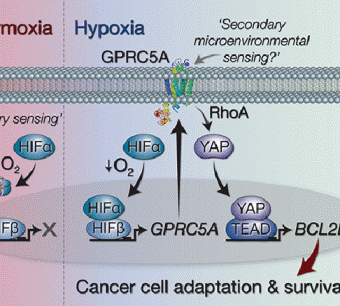



Business Inquiry
Global:
Email:marketing@medicilon.com
+1(781)535-1428(U.S.)
0044 7790 816 954 (Europe)
China:
Email: marketing@medicilon.com.cn
Tel: +86 (21) 5859-1500



Low-oxygen conditions ought to suffocate cells, but somehow cancer cells survive. They even progress and spread more aggressively, thanks to a newly identified signaling pathway, the HIF-GPRC5A-YAP axis. Blocking this pathway, scientists suggest, could choke cancer. The pathway appears to be “druggable” because it depends on a G protein-coupled receptor (GPCR), a type of receptor commonly targeted by drugs. Also, the receptor does not appear to be useful to normal cells, so interfering with it could stifle cancer cells without harming healthy tissue.

The pathway was identified by University of Bristol scientists who worked with cancer cells grown in dishes, mouse models, and with a molecular biology technique called proteomics. Essentially, the scientists determined which proteins are present at elevated levels in cancer cells that are subjected to hypoxia, or oxygen-deficient conditions – conditions of the sort that arise when rumors grow faster than their blood supply.
The results of this work appeared in the journal EMBO Molecular Medicine, in an article titled, “Cancer cell adaptation to hypoxia involves a HIF-GPRC5A-YAP axis.”
“Using genetic approaches in vitro and in vivo, we reveal HIFs as direct activators of GPRC5A transcription,” wrote the article’s authors. “Furthermore, we find that GPRC5A is upregulated in the colonic epithelium of patients with mesenteric ischemia, and in colorectal cancers high GPRC5A correlates with hypoxia gene signatures and poor clinical outcomes.”
Previous studies had shown that tumor cells in hypoxic regions switch on an adaptive transcriptional response mediated primarily by hypoxia-inducible factors (HIFs) that help them survive and continue to grow. Transcriptional regulators, however, are considered difficult therapeutic targets. Could more attractive, more druggable, mediators of hypoxic cancer cell survival be identified?
That was the task facing the Bristol scientists, who were led by Alexander Greenhough, Ph.D., a researcher at Bristol’s School of Cellular and Molecular Medicine.
“Hypoxia is considered an excellent target for cancer therapy because it generally features in cancers rather than healthy tissues,” Dr. Greenhough explains. “However, finding ways to effectively exploit this difference in the clinic is a major challenge.”
“This work,” he continues “advances our knowledge of hypoxic cancer cell behavior and take us a step closer toward developing novel therapies that could achieve this goal.”
In the current study, Dr. Greenhough’s team showed that GPRC5A (G Protein-coupled Receptor Class C, Group 5, Member A) – an orphan GPCR of poorly understood regulation and function – is a bona fide transcriptional target of HIFs both in vitro and in vivo.
“Mechanistically, we show that GPRC5A enables hypoxic cell survival by activating the Hippo pathway effector YAP and its anti-apoptotic target gene BCL2L1,” the EMBO Molecular Medicine article detailed. “Importantly, we show that the apoptosis induced by GPRC5A depletion in hypoxia can be rescued by constitutively active YAP.”
“This type of receptor is a GPCR, which are considered to be among the best drug targets for many diseases,” Dr. Greenhough points out. “We would like to know whether this receptor serves as a biomarker for more aggressive cancers that are resistant to therapy, and whether it has roles in other diseases where hypoxia or inflammation is implicated, which could lead to advances in regenerative medicine as well as oncology.”
 Relevant
news
Relevant
news